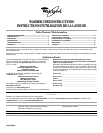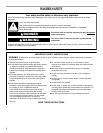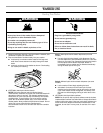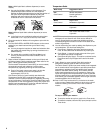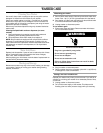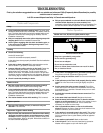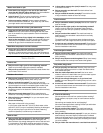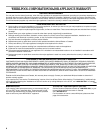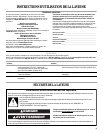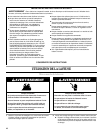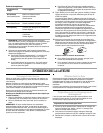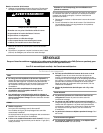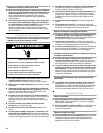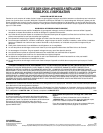
4
Style 1: With liquid fabric softener dispenser (on some
models)
■ Use only liquid fabric softener in this dispenser. Pour
measured liquid fabric softener into the dispenser.
Softener is added automatically during the rinse portion of
the cycle. Dilute liquid fabric softener by filling the
dispenser with warm water until liquid reaches the
underside of the rim. See max fill line arrows.
Style 2: Without liquid fabric softener dispenser (on some
models)
■ In the final rinse only, add fabric softener that has been
diluted with ¹⁄₂ to 1 cup (125 to 250 mL) warm water.
5. Close the washer lid. Washer will not agitate or spin with the
lid open.
6. Turn the LOAD SIZE or WATER LEVEL selector to the correct
setting for your wash load and the type of fabric being
washed.
■ You may change the load size or water level selection after
the washer has started filling by turning the selector to a
different setting.
■ On models with a variable Load Size or Water Level
control, you should turn the knob to RESET, then to
desired setting.
7. Select a Wash Temperature based on the type of fabric and
soil being washed. Use the warmest wash water safe for the
fabric. Follow garment label instructions.
The Automatic Temperature Control (ATC) (on some models)
electronically senses and maintains a uniform water
temperature by regulating incoming hot and cold water.
■ Even in Cool wash, some warm water is let into the
washer to maintain a minimum temperature of
approximately 70ºF (21ºC).
Care Control Temps (on some models) uses Automatic
Temperature Control (ATC) to electronically sense and
maintain a uniform water temperature by regulating incoming
hot and cold water. Care Control Temps provides higher wash
temperatures for the more aggressive, heavy-duty cycles and
slightly lower temperatures on cycles for delicate and hand
wash items, to provide better fabric care.
Temperature Guide
NOTE: In wash water temperatures colder than 60°F (15.6°C),
detergents do not dissolve well. Soils can be difficult to
remove. Some fabrics can retain wear wrinkles and have
increased pilling (the formation of small lint-like balls on the
surface of garments).
8. You can customize your wash by adding rinse Options to your
cycle selections. This knob has settings for:
■ Extra Rinse - Selecting this option provides a second
rinse. An Extra Rinse can be added to any wash cycle.
■ Cycle Signal - A tone will sound at the end of the cycle.
The sound level cannot be adjusted.
■ Extra Rinse & Cycle Signal - This option combines both a
Extra Rinse and a Cycle Signal at the end of the wash
cycle.
9. Fabric Select (on some models). Each fabric setting is
designed for different types of fabric and soil levels.
The Fabric Sense™ System (on some models) is an integrated
set of controls which work together to provide optimal wash
temperatures, agitation times, and agitation/spin speeds
based on the Fabric Select setting. The controls provide
higher wash temperatures for more aggressive, heavy-duty
cycles
and slightly lower temperatures on cycles for delicate
and hand wash items, to provide better fabric care.
The timer
knob allows you to decrease agitation time for light soils and
increase agitation time for heavy soils.
10. Push in the Timer knob and turn it clockwise to the wash
cycle you want. Reduce the wash time when using a small
water level setting. Pull out the Timer knob to start the
washer.
To stop or restart your washer:
■ To stop the washer at any time, push in the Timer knob.
■ To restart the washer, close the lid (if open) and pull out the
Timer knob.
Wash Temp Suggested Fabrics
Hot
Care Control
Whites and pastels
Durable garments
Heavy soils
Warm
Care Control
Bright colors
Moderate to light soils
Cool Colors that bleed or fade
Light soils
Cold Dark colors that bleed or fade
Light soils



